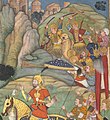File:Military band behind Emperor Humayun.jpg
Appearance

Size of this preview: 550 × 600 pixels. Other resolutions: 220 × 240 pixels | 440 × 480 pixels | 704 × 768 pixels | 939 × 1,024 pixels | 1,899 × 2,071 pixels.
Original file (1,899 × 2,071 pixels, file size: 2.14 MB, MIME type: image/jpeg)
File history
Click on a date/time to view the file as it appeared at that time.
| Date/Time | Thumbnail | Dimensions | User | Comment | |
|---|---|---|---|---|---|
| current | 12:58, 14 December 2022 |  | 1,899 × 2,071 (2.14 MB) | Jacqke | Uploaded a work by Unknown artist, Mughal Empire, circa 1590 A.D. from Cleveland Museum of Art cropped Wikimedia Commons image: File:Anonymous - Mughal ruler Humayun defeating the Afghans before reconquering India, folio from an Akbar-nama (Book of Akbar) of Abu’l Fazl (Indian, 1551–1602) - 1971.77 - Cleveland Museum of Art.tiff with UploadWizard |
File usage
The following page uses this file:
Global file usage
The following other wikis use this file:
- Usage on id.wikipedia.org


